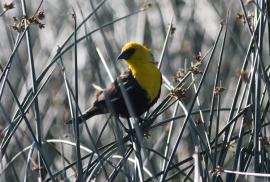Guide to Boreal Birds
Overview
In spring, visiting a Yellow-headed Blackbird colony in a marsh or slough is an exciting experience. The surrounding water provides safety but often limits the nesting habitat; crowding is thus inevitable. Some males are always in display flight, with head stooped, feet and tail drooped, wings beating in a slow, accentuated way. Some quarrel with neighbors over boundaries while others fly out to feed. Approaching predators are mobbed by clouds of Yellow-headed Blackbirds and neighboring Red-wings, which nest in the drier stands of cattails.
Description
8-11" (20-28 cm). Robin-sized. Male much larger than female. Male is bright yellow on head, neck and upper breast, blackish elsewhere, with conspicuous white markings on wings. Female duller and lighter; yellow on chest, throat, and face; no white wing marks.
Voice
Harsh, incessant oka-wee-wee and kruck calls, coming from many individuals in a colony, blend into a loud, wavering chorus.
Nesting
3-5 brown-speckled whitish eggs in a basket woven around several strong stalks. Nests in colonies.
Habitat
Freshwater marshes.
Range/Migration
Although this marsh-loving species has similar habitat requirements to those of its relative the Red-winged Blackbird, it is less cold-tolerant than the Red-winged and retreats farther southward. Yellow-headed Blackbirds leave most of their breeding areas and occupy a winter range that stretches from the extreme southwestern United States to central Mexico. During winter, the flocks are segregated by sex; males are predominant in the northern portions of the wintering area, females in the southern. Yellow-headed Blackbirds migrate in large flocks that are segregated by sex and age. Arrival on the breeding grounds in spring is an orderly process. Mature males migrate first, followed by mature females as much as two weeks later. Next come the first-year males, followed in about a week by first-year females. Drainage of wetlands and other alterations of freshwater habitat (including irrigation practices and habitat destruction caused by overgrazing) pose a serious threat to this species, particularly in northern Mexico and the southwestern United States.
Breeds from central British Columbia, northern Alberta, and Wisconsin south to southern California, northern New Mexico, and Illinois. Winters mainly in Southwest and Mexico.



